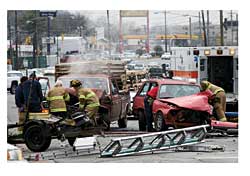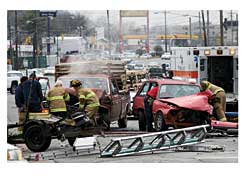
Under Pressure
Heroes on Call
No industrial worker faces the array of hazards these stalwarts do. Our trusty responders work feverishly in hostile terrain.
 LIGHTNING-FAST, acutely accurate assessment under pressure and with little information is a matter of course, as is providing consistent, standardized response to life-threatening emergencies--the framework of a first responder's actions. Does it sound easy? These personnel have to project calm reassurance to the victims, no matter what is happening at that moment and, all the while, they're busy saving someone's life. No industrial worker faces the dangerous and constantly changing hazards in unknown terrain to this level.
LIGHTNING-FAST, acutely accurate assessment under pressure and with little information is a matter of course, as is providing consistent, standardized response to life-threatening emergencies--the framework of a first responder's actions. Does it sound easy? These personnel have to project calm reassurance to the victims, no matter what is happening at that moment and, all the while, they're busy saving someone's life. No industrial worker faces the dangerous and constantly changing hazards in unknown terrain to this level.
Add in a few extra problems, such as communication difficulties, disease, raw sewage, severe weather, high speed, road hazards, toxic chemical exposures, physical hazards resulting from earthquakes or hurricanes or other natural disasters, confined space dangers, cave-ins, entrapment, engulfment, electrocution, vehicle dangers, gunfire, animal-related injury, insects and other venomous critters that bite, and your mind goes numb. Unusual rescue situations such as mountain terrain, icy conditions, or swollen river recovery add even more problems to an already stressful
situation. This is only an inkling of the dangers and stressors dealt with daily by first responders, our "heroes on call."
It is the responsibility of the employing agency to assess and recognize health warnings among responders and provide assistance.
All across the nation and the world, these dedicated professionals are waiting for the next response situation. At a moment's notice they leave jobs, families, and regular lives (often in the danger zone) to assist those in need. Personal lives are placed on hold often to serve, protect, and assist the public.
Any one issue is enough to cause problems. Combined dangers for first responders catapult the danger level higher and higher while the media record the action with ever-more-alarming volume and family members watch loved ones in danger from home.
Often first responders rely solely on training, those emergency supplies they can carry, and common sense to succeed until backup arrives, be it minutes or days. One quick glance at the news is enough to identify only a small sampling of the daily response team's work conditions that range from mining disasters and derailments to ice storms, assaults, fires, storms, floods, tornadoes, and more.
Emergency responses take all shapes and sizes, and they frequently involve multiple agencies, including fire, law enforcement, hazmat, and utilities. We all know training is one of the most important areas for any first responder; finally, cross training has come of age because today's first responders must have a general working knowledge of other agency responsibilities and needs. For example, more first responders are learning heavy equipment handling so that time delays are reduced.
The finest of human character shows during emergency situations in our first responders. They balance critical treatment, knowing what to do and when to do it.
Public sensitivity in crisis situations is something they do well, usually without complaint. The most assured thing to face any first responder is the unknown--the uncertainty of a situation. Properly trained and equipped first responders reduce the dangers of the job to the greatest extent possible by utilizing known safety and health preventions, such as sharps containment, PPE, protective apparel, and quick follow-up if/when injured.
Communication issues facing first responders abound. They encounter background noise, language barriers, medical impairments, psychological issues, and other impairment of those needing aid or treatment, such as drug or alcohol use.
Stress and Support On the Job, At Home
There are hazards to being first on the scene. Often it is a dangerous but educated best guess case of "blind man's bluff" trying to balance the critical care of someone who may die if not treated with watching out for potential hazards for yourself and co-workers. The dangers are the same, whether the first responder is a volunteer or paid employee.
The big picture of First Response is simple: Every conceivable occupational hazard exists, with no prior notice or second chance. Many incorrectly think of fire as the first responder's worst hazard, but single or multiple dangers lurk, including chemicals, bioweapons, and the unknown, long-term consequences of exposures and infectious diseases. Stress is present in the field and at home: physical stress, behavior stress, fear, helplessness, nightmares, and, of course, the media and public exposure. After all, we are discussing human beings, not machines.
Every effort we can achieve to support these heroes minimizes social, economic, and environmental harm
We think of occupational safety as prevention. We plan and plan more for "what if" situations, but for the first responder, this is only part of the answer. Prevention means training and equipment and emotional support for the tough times. It means counseling when needed for the overwhelming burden of stress in the workplace for someone who does not want to appear weak or needing help. Being first on the scene often means the realization of gruesome horror scenes . . . a murdered child, family violence, extensive burns. The first moments of treatment can be frenzied with panic, fear, anger, or helplessness. The aftereffects can last a lifetime if not dealt with constructively.
Safety professionals know that stress is not like a light switch--the images of such tragic events often haunt the responder into his or her home life, piling more pressure on other events. Ill health effects can include high blood pressure, sleep disorders, alcohol or sleeping aid abuse, anger, withdrawal from family members, over-protectiveness for family members, and even paranoia. It is the responsibility of the employing agency to assess and recognize the warning signs of such problems and provide assistance.
Training and preparation of every first responder is fundamentally the most important short- and long-term goal we as a profession can have. These dedicated people, both volunteer and paid, may be unseen and underfunded until a crisis happens. When it does, there is no time to plan the response; it must be second nature combined with confidence and dedication. Every member of the response team must be superbly trained to handle whatever horrors face them.
While many imagine themselves tough enough, physically strong enough, mentally stable enough, and occupationally prepared to do this work, few actually can excel at it long term. We look to these men and women as a torch in the night during a crisis, but they burn out, too. I believe whatever statistics exist cannot help but underreport the physical and emotional toll these jobs take on thousands of first responders and their family members.
We know workers' safety is best achieved through prevention. Yet first responders can not alter or ignore the emergencies to which they're called. We also know safety is achieved through preparation of not only the team, but also the individual, having the necessary tools on hand, with sufficient training and support, including emotional support to reduce the toll on lives that seeing such carnage can exact.
Every effort we can achieve to support these heroes minimizes social, economic, and environmental harm. As a community, safety and health commends and supports their daily and life sacrifices.
This article appeared in the March 2007 issue of Occupational Health & Safety.
First Responder Resources
Federal agencies
Magazines and journals
|
This article originally appeared in the March 2007 issue of Occupational Health & Safety.